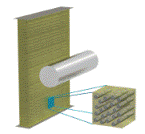Mechanical and Materials Engineering, Department of

Department of Engineering Mechanics: Dissertations, Theses, and Student Research
Date of this Version
Winter 12-1-2011
Document Type
Dissertation
Abstract
Determinations of Some polycrystalline ceramics’ strength properties and inelastic deformation mechanisms in the shocked state are critically important to the design and optimization of armor structures involving these materials. In this work, multiscale modeling and simulations have been carried out to study strength of the effects of polycrystalline microstructure, crystal anisotropy, porosity, and their interactions with microscopic deformation/damage mechanisms on the responses of several polycrystalline ceramics under shock compression and to extract their shock strengths from the wave profiles measured in the related plate impact shock wave experiments.
With a mesoscopic computational model, the roles of intragranular microplasticity and deformation twinning, intergranular microdamage, and voids in the inelastic deformations and shock strengths of two polycrystalline a-phase aluminum oxides, Lucalox and AD995 have been examined. The results show that microplasticity by combined (primary) prismatic and (secondary) basal slips can well capture the characteristic features observed experimentally for shocked Lucalox. For AD995, the results show that porosity has a much more significant role than glassy grain boundaries in causing its lower shock strength than Lucalox. Its shock response can be well modeled by a combination of void-induced intense basal twinning and prismatic slip. The mesoscopic model has also been used to extract from the available experimental data the crystal elasticity and plasticity properties of aluminum oxynitride (AlON).
At the macroscopic level, a homogeneous continuum model, which combines nonlinear elasticity and pressure-dependent plasticity for effective strength description has been proposed. A procedure for determining the material parameters via matching the model simulations with the available shock wave profile measurements has been demonstrated for AlON and for a polycrystalline a-6H silicon carbide (SiC-N).
Finally, a new finite element piezoresistance model for interpreting the measurement of a manganin stress gauge has been developed and calibrated with the longitudinal gauge measurements obtained in the shock-compressed SiC-N. The calibrations for the gauge in both the longitudinal and lateral configurations have been obtained. This enables the determination of ceramic shock strength directly from the gauge measurements in the two configurations.
Advisor: Ruqiang Feng


Comments
A dissertation Presented to the Faculty of The Graduate College at University of Nebraska In Partial Fulfillment of Requirements For the Degree of Doctor of Philosophy, Major: Engineering (Engineering Mechanics), Under the Supervision of Professor Ruqiang Feng. Lincoln, Nebraska: December, 2011
Copyright (c) 2011 Jianbin Zhu